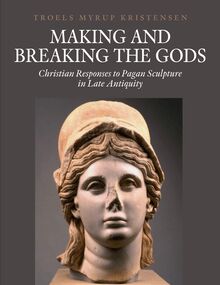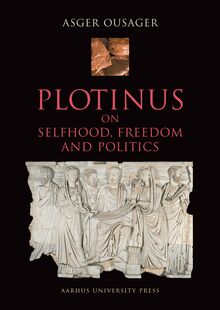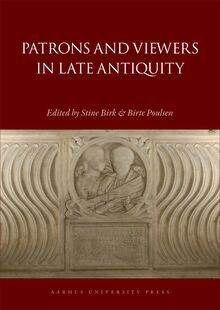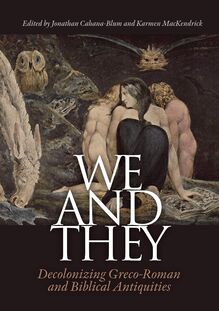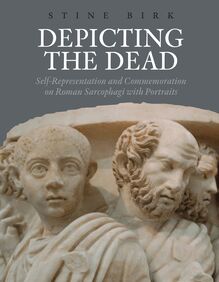Making and Breaking the Gods , livre ebook
298
pages
English
Ebooks
2013
Obtenez un accès à la bibliothèque pour le consulter en ligne En savoir plus
Découvre YouScribe en t'inscrivant gratuitement
Découvre YouScribe en t'inscrivant gratuitement
298
pages
English
Ebooks
2013
Obtenez un accès à la bibliothèque pour le consulter en ligne En savoir plus
Publié par
Date de parution
30 juin 2013
Nombre de lectures
3
EAN13
9788771244120
Langue
English
Poids de l'ouvrage
34 Mo
Publié par
Date de parution
30 juin 2013
Nombre de lectures
3
EAN13
9788771244120
Langue
English
Poids de l'ouvrage
34 Mo
Kristensen MAKing And B re AKing the gods
A A rhus s tudies in Mediterr A ne A n Antiquity V olu M e Xii
t r oels Myrup Kristensen
MAKing A nd
BreAKing the g ods
Christian Responses to Pagan Sculpture
in Late Antiquity
drawing on both textual and archaeological sources, this book
discusses how Christians in late Antiquity negotiated the sculptural
environment of cities and sanctuaries in a variety of ways, ranging
from creative transformations to iconoclastic performances.
their responses to pagan sculpture present a rich window into the
mechanisms through which society and culture changed under
the influence of Christianity. the book thus demonstrates how
Christian responses to pagan sculpture rhetorically continued an
old tradition of discussing visual practices and the materiality of
divine representations. Focusing in particular on egypt and
the near east, it furthermore argues that Christian responses
encompass much more than mindless violence and need to be
contextualised against other social and political developments,
as well as local traditions of representation.
aA A rhus u ni V ersity p ress
94853_cover_making-and-breaking-the-gods_r1_.indd 1 10/3/13 3:05 PMMaking and
Breaking the Gods
This page is protected by copyright and may not be redistributedAarhus Studies in
Mediterranean Antiquity
(ASMA)
XII
ASMA is a series which is published approximately once a year by the research
programme Classical Antiquity at Aarhus University, Denmark.
Te programme includes researchers from various disciplines studying
GraecoRoman Antiquity, such as Classical Archaeology, Classical Philology, Ancient
History, the Study of Religion, and Teology.
Te objective of the series is to advance the interdisciplinary study of Antiquity
by publishing articles, e.g., conference papers, or independent monographs,
which among other things refect the current activities of the programme.
This page is protected by copyright and may not be redistributedMaking and
Breaking the Gods
Christian Responses to Pagan
Sculpture in Late Antiquity
Troels Myrup Kristensen
Aarhus University Press |
This page is protected by copyright and may not be redistributedMaking and Breaking the Gods
© Aarhus University Press and the author 2013
Cover by Jørgen Sparre
Cover. Head of Athena from Tel Naharon, dated
to the second century and buried in a pit in Late
Antiquity, Israel Museum, Jerusalem, inv. IAA
78.505 (courtesy of the Israel Museum).
Back cover. The so-called “Guidi Head”, the
head of the cult statue of Zeus from his temple
at Cyrene, as reconstructed from numerous
fragments (courtesy of Donald White).
Typeset with Adobe Garamond
Ebook production: Narayana Press
ISBN 978 87 7124 412 0
ISSN 1399 2686
Aarhus University Press
Langelandsgade 177
DK-8200 Aarhus N
www.unipress.dk
International distributors:
Gazelle Book Services Ltd.
White Cross Mills
Hightown, Lancaster, LA1 4XS
United Kingdom
www.gazellebookservices.co.uk
IS Distribution
70 Enterprise Drive
Bristol, CT 06010
USA
Published with the financial support of
Aarhus University Research Foundation
Ny Carlsberg FoundationCONTENTS
Acknowledgements 7
Introduction
Driving Demons Away: The World of Demeas 9
Frameworks 22
Chapter 1
Making and Breaking the Gods: From Roman Visual
Practices to Christian Response 39
Making the Gods: Roman Religion and Visual Practices 43
Staging Divine Presence 52
Breaking the Gods: Christian Perspectives 65
Rhetoric and Reality in Christian Texts 76
Why Did Christians Destroy Pagan Sculpture? 85
Interpreting Response: Selective Destruction as a Framework 89
Chapter 2
The Semantics of Christian Response: Pagan Sculpture
in the Sacred Spaces of Egypt 107
Approaching Egypt 109
Christian Responses to Pagan Sculpture in Alexandria 118
The Destruction of the Serapeum and its Statuary 119
Further Christian Responses to Pagan Sculpture in Alexandria 125
Responses to Pagan Sculpture in Alexandria’s Hinterland 129
The Range of Responses to Pagan Sculpture in Alexandria 134
Christian Responses to Pe in the Nile Valley 135
Iconoclasm and Triumphal Narratives in the Nile Valley 137
Christians and the Pagan Past at Abydos and Dendara 146
Responses to Pagan Sculpture in the Theban Region 158
Embodied Images: Representation and Response in Egypt 175
Images and Bodies in Egyptian Culture 176
Idols on Trial: Representation and Corporal Punishment 180
Negating Movement: The Perception of Feet in Christian Response 183
Sin, Nudity, and the Power of Phallic Images 186
Selective Destruction in Late Antique Egypt 190
Christian Response and the Transformation of Sacred Space in Egypt 192
Contents 5
This page is protected by copyright and may not be redistributedChapter 3
Re-Imagining Idols: Christian Responses to Pagan Sculpture
in the Urban Spaces of the Near East 197
Approaching the Near East 200
Christianization and Memory in the Late Antique Near East 206
Christian Response in Environments of Urban
Continuity: Palmyra and Scythopolis 211
The Life and Afterlife of a Goddess at Palmyra 211
Liminal Places and Christian Response at Scythopolis 218
Displaying Pagan Statues in the Contested Cityscapes of the
Near East: Caesarea Maritima and Beyond 232
Displaying Pagan Statues in Caesarea Maritima 232
Re-Imagining the Cityscape at Caesarea Philippi 246
The End of the ‘Statue Habit’ in the Near East: Pagan Statues
and Bathing Culture at Hammat Gader 248
Conclusion
Christian Response and the Viewing Culture of Late Antiquity 253
Bibliography 261
Index 289
6 Contents
This page is protected by copyright and may not be redistributedAcknowledgements
Tis book is a substantially revised version of my dissertation, Archaeology of Response:
Christian Destruction, Mutilation, and Transformation of Pagan Sculpture in Late Antiquity,
written in the Department of Classical Archaeology, Aarhus University, between 2007
and 2009, under the supervision of professor emeritus Niels Hannestad and professor
Lea Stirling. Te dissertation was defended in December 2009; since then I have been
able to revise it and add some new material, although several important works arrived
too late to be taken into closer consideration (notably Verity P Facing the Glatt’s ods.
Epiphany and Representation in Graeco-Roman Art, Literature and Religion, Cambridge
2011, which adds much to our understanding of Greek and Roman cult statues). Te
fnal rewrite was completed in the shady café of Bodrum Castle in summer 2012, and
only very minor adjustments have been possible since then.
One chapter dealing with Christian crosses on pagan statuary that formed part of
the original dissertation has been published separately (Kristensen 2012). Earlier v - er
sions of parts of this book have appeared in previous publications (Kristensen 2009,
which appears by permission of Joh ns Hopkins University Press; 2010a and 2010b).
Te original dissertation also included an appendix on the diverse late and post antique
treatment of Roman sculpture. However, since this appendix will soon be superseded
by the volume Te Afterlife of Roman Sculpture – Late Antique Responses and Practices
(Kristensen & Stirling forthcoming), I decided that it would be superfuous to include it
here. Te contributions to that volume, which is based on two seminars held in Aarhus
in September 2008 and March 2011 respectively, will explore many facets of late antique
responses to statuary that complement those under discussion here.
Numerous individuals and institutions have been instrumental in supporting my
work, and I would like to single out Birte Poulsen, Peter Stewart, Eric Varner (the three
examiners at my defense), and Lea Stirling for all of their encouragement and advice,
especially during the occasionally cumbersome process of reshaping the dissertation
into a book. Lea Stirling in particular has followed this project from beginning to end
and has always ofered her expertise and help. For this, I am immensely grateful, and
this book (as well as the original dissertation) would have been worse of without her.
I hope this fnal version does not let her down.
My dissertation research was funded by the Danish Research Council through the
collaborative project “Art and Social Identities in Late Antiquity”, which ran from 2007
to 2010. Another major factor in shaping the project came through the generous
support of an EliteForsk trav elling fellowship from the Danish Ministry of Science. Most
importantly, the fellowship funded research travel in Italy, Egypt, Syria, Jordan, Israel,
and Lebanon as well as a visiting studentship in the Faculty of Classics and King-’s Col
lege, University of Cambridge, during the spring and summer of 2009, which allowed
Acknowledgements 7
Contents Index
This page is protected by copyright and may not be redistributedme to fnish the writing of the dissertation. In Cambridge, I am particularly grateful to
Robin Osborne for commenting on drafts, and to the participants of the Visual Culture
seminar for stimulating discussions on a wide range of issues that broadened the scope
of both my thinking and writing. Ideas and early versions were also tried out at - semi
nars and conferences in Aarhus, Athens, Berlin, Cambridge, Copenhagen, Damascus,
Leicester, Lund, Oxford, Rome, San Diego, Southampton, Stockholm, and Zadar. I am
thankful to the audiences and organizers at all of these occasions for providing critique,
feedback and helpful suggestions.
I would like to ackno wledge the support of the Danish Institute in Athens and
the Danish Academy in Rome, the latter especially for the award of a residential
fellowship in the spring of 2011 that allowed me to revisit the text and incorporate new
research that had arrived too late for the dissertation. On that occasion, I was able to
visit the Syrian sanctuary on the Janiculum, thanks to the Soprintendenza Archeologica
di Roma and the assistance of Bente Rasmussen at the Danish Academy. I also thank
the anonymous
